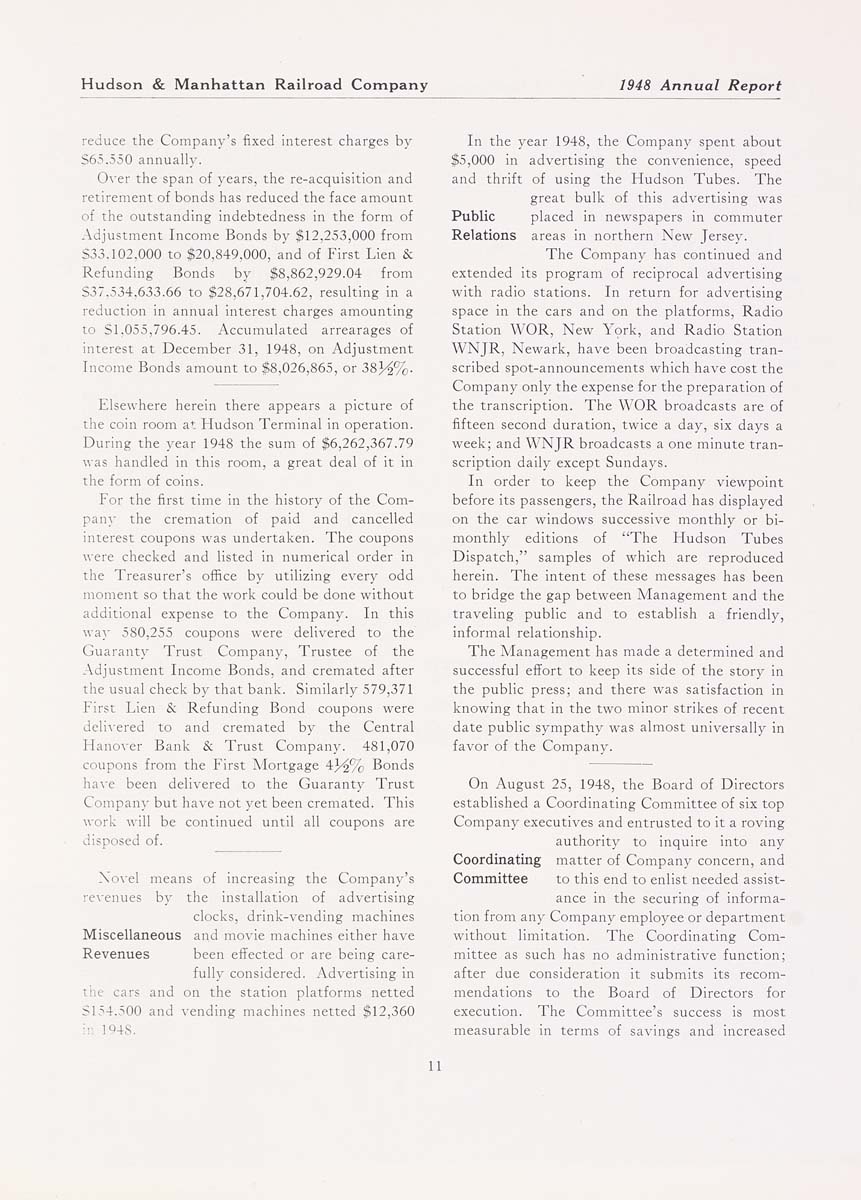Annual report of Hudson & Manhattan Railroad Company
(New York, N.Y. : Hudson and Manhattan Railroad Company )
|
||
|
|
|
|
| 1948: Page 11 |

Hudson & Manhattan Railroad Company 1948 Annual Report reduce the Company's fixed interest charges by S65.550 annually. 0\'er the span of years, the re-acquisition and retirement of bonds has reduced the face amount of the outstanding Indebtedness in the form of Adjustment Income Bonds by $12,253,000 from 533,102,000 to $20,849,000, and of First Lien & Refunding Bonds by $8,862,929.04 from 537.534,633.66 to $28,671,704.62, resulting in a reduction in annual Interest charges amounting to 51-055,796.45. Accumulated arrearages of Interest at December 31, 1948, on Adjustment Income Bonds amount to $8,026,865, or 38^%. Elsewhere herein there appears a picture of the coin room at Hudson Terminal in operation. During the year 1948 the sum of $6,262,367.79 was handled in this room, a great deal of it in the form of coins. For the first time in the history of the Com¬ pany the cremation of paid and cancelled interest coupons was undertaken. The coupons were checked and listed in numerical order in the Treasurer's office by utilizing every odd moment so that the work could be done without additional expense to the Company. In this way 580,255 coupons were delivered to the Guaranty Trust Company, Trustee of the Adjustment Income Bonds, and cremated after the usual check by that bank. Similarly 579,371 First Lien & Refunding Bond coupons were delivered to and cremated by the Central Hanover Bank & Trust Company. 481,070 coupons from the First Mortgage 4^% Bonds have been delivered to the Guaranty Trust Company but have not yet been cremated. This work will be continued until all coupons are disposed of. No^'el means of increasing the Company's re\'enues b}" the installation of advertising clocks, drink-vending machines Miscellaneous and movie machines either have Revenues been effected or are being care¬ fully considered. Advertising in liic cars and on the station platforms netted 5154.500 and vending machines netted $12,360 Iv. 1Q4S. In the year 1948, the Company spent about $5,000 in advertising the convenience, speed and thrift of using the Hudson Tubes. The great bulk of this advertising was Public placed in newspapers in commuter Relations areas in northern New Jersey. The Company has continued and extended its program of reciprocal advertising with radio stations. In return for advertising space in the cars and on the platforms, Radio Station WOR, New York, and Radio Station WNJR, Newark, have been broadcasting tran¬ scribed spot-announcements which have cost the Company only the expense for the preparation of the transcription. The W^OR broadcasts are of fifteen second duration, twice a day, six days a w-eek; and WNJR broadcasts a one minute tran¬ scription daily except Sundays. In order to keep the Company viewpoint before Its passengers, the Railroad has displayed on the car wdndows successive monthly or bi¬ monthly editions of "The Hudson Tubes Dispatch," samples of which are reproduced herein. The intent of these messages has been to bridge the gap between Management and the traveling public and to establish a friendly. Informal relationship. The Management has made a determined and successful effort to keep its side of the story in the public press; and there was satisfaction in knowing that in the tw-o minor strikes of recent date public sympathy was almost universally in favor of the Company. On August 25, 1948, the Board of Directors established a Coordinating Committee of six top Company executives and entrusted to it a roving authority to Inquire Into any Coordinating matter of Company concern, and Committee to this end to enlist needed assist¬ ance in the securing of Informa¬ tion from any Company employee or department w-ithout limitation. The Coordinating Com¬ mittee as such has no administrative function; after due consideration it submits Its recom¬ mendations to the Board of Directors for execution. The Committee's success is most measurable in terms of savings and Increased |
| 1948: Page 11 |







